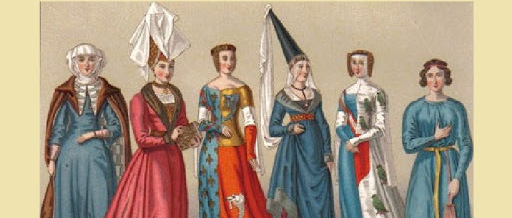Medieval Womens Clothing
Posted on 1st January 2021
The middle ages spanned a long period and the styles of clothing changed over time. In the later period ladies clothing became tighter and more fitted to show off a lady’s figure.
Clothing was made from linen and wool.
Poor – Rough linen and poor-quality wool were used. Often the poor would only have one outfit to wear that they made themselves, so clothing was rarely washed.
Wealthy – Also used linen and wool, however the quality was better; they also had their clothes specially made. With the rise in trade, they were also able to buy silk, taffeta, velvet and fur. The wealthy liked to embellish their clothing with embroidered hems and borders, and bright rich dyes and fur collars.
Undergarment - A full ankle length long-sleeved garment made of linen.
Dress (Kirtle) - A full ankle length one-piece sleeveless dress made of wool or sheepskin, belted at the waist.
Tunic (Apron) - A shorter one-piece item worn over the dress.
Cloak - A full ankle length item draped over the shoulders, fastened with a brooch or pin at the shoulder. The poor made this out of wool, the wealthy made the cloak from velvet and/or trimmed it in fur.
Coat/outer garment (Surcoat) - An open bodice and a full-length skirt that trailed to the floor.
Stockings - Made of wool to cover the legs.
Head covering (wimple) - A garment that went over the head, around the face and covered the neck and chin.
As the middle ages progressed, tighter fitting clothing with lower necklines became fashionable.
Lacing - Added across the bodice, pulled tight to enhance a lady’s figure.
Wide belt (girdle) - Worn at the waist to give the appearance of a longer waist.
Dresses – With long trailing sleeves that were tied at the elbow giving a bell shape; although later still the sleeves became shorter.
Headwear became much more elaborate.
Cone shaped hat (Hennin) – Pointed hats, generally 30 – 45cm (12 – 18in) high, although could also be considerably higher. A veil was attached to the back of the hat, starting at the point and flowing down over the shoulders, sometimes to the floor.
These hats were initially worn by noble women only but became more widespread over time.
Leather shoes - Became pointed or cone shaped during the later middle ages.
Tagged as: Junior Middle Ages
Share this post:





